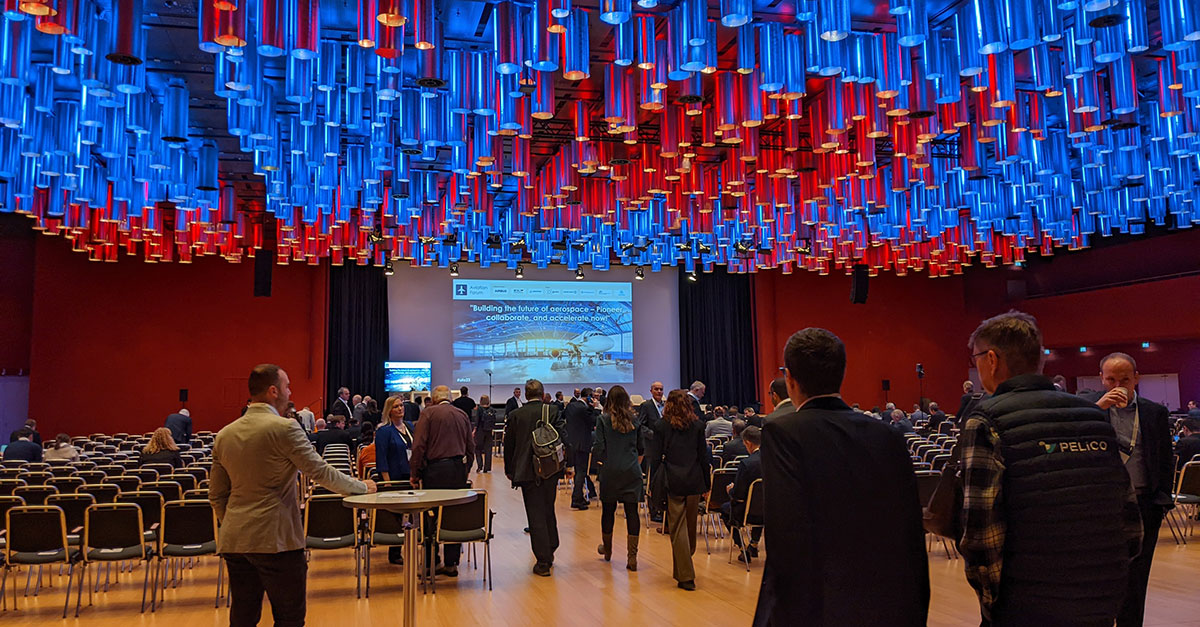Digital transformation in the aerospace industry
![]()
Digital Transformation in the Aerospace Industry: The French business magazine L´Usine Nouvelle has published a comprehensive article about the Digitalization of the Aerospace Supply Chain: The Airbus Group, Dassault Aviation, Thales and Safran extend the usage of AirSupply – the industry platform that has been initiated by these companies in 2011 – to the whole Aerospace supply chain.
All you need to know about the purpose of this initiative, the experience of the users and the benefits you will find here in the English translation of the article.
Aircraft components are well looked after at the Potez factory in Aire-sur-l’Adour (Landes), located near Pau, France. In fact, they spend several weeks at the factory where they are cut and painted, before being sent to one of the family-run group’s customers. At the other end of the production chain is Airbus; the renowned company employs 14,000 people in Toulouse. And between both companies is a myriad of stakeholders, from SMEs to tier-1 sub-contractors such as Daher and Aircelle, with long manufacturing cycles.
The aim behind this “extended enterprise”, as Marwan Lahoud, Chairman of the French Aerospace Industries Association (GIFAS), defines it, is to establish a common means of communication with the aid of digital technology. At least that was GIFAS’s goal in 2009, when it decided to launch BoostAeroSpace, a digital platform which standardizes exchanges between industry stakeholders.
It is comprised of three services: AirDesign, operated by Dassault Systèmes, for pooling scale models, 3D models and configurations of products, AirCollab, operated by Thales, for sharing documents and organizing meetings, and AirSupply, run by the German company SupplyOn, for following up on orders and deliveries.
What’s more, the entire platform is accessible via the cloud. “BoostAeroSpace makes it easier for suppliers and sub-contractors to connect with their customers by providing them with a single portal,” explains Laurent Martin-Rohmer, AirSupply Manager at SupplyOn.
Handling five or six different systems was costing sub-contractors a lot of time and money. For example, Latecoere estimates this caused an additional 10% in engineering costs. Agreeing on standard procedures allows stakeholders in the aerospace industry to focus on operations with the most added value, which is essential for increasing competitiveness and coping with the sharp increase in the number of programs.
While the rollout of AirDesign is still in the early stages, AirCollab and AirSupply are more advanced. Around 1,000 companies use AirCollab and more than 2,000 customer/supplier relationships are registered on AirSupply. Out of the three services, AirSupply enables the greatest level of interaction between customers and suppliers. Laurent Martin-Rohmer believes that the use thereof will result in an average time-savings of 10% with regard to administrative activities. Therefore, customers and suppliers can reach agreements on orders early in the process.
“The benefits of AirSupply correspond to each customer: increased responsiveness when collaborating over quantities and delivery time frames, fewer supply disruptions, reduced stock levels, fewer outstanding amounts, and improved reputations, etc.,” says Martin-Rohmer. For some, it’s a way of expressing their willingness to contracting parties who tend to rely on foreign suppliers. However, AirSupply is not a “marketplace”, he explains. “The aim is not to use it to look for contracts. The platform only reproduces existing relationships between customers and suppliers.” In addition, it can be used by non-European suppliers and is intended to include an increasing number of them.
Collaborating on orders … and delays
In addition to the rather classic functions of validating orders and issuing shipping notifications and delivery notes, AirSupply provides more innovative services such as collaborative on-time delivery (OTD). This is an indicator which is calculated by contracting parties for the purpose of measuring a supplier’s performance based on the number of orders delivered on time. All sub-contractors have received a negative OTD at least once for various reasons: a last-minute change in a component’s design, or a machine has broken down, etc.
The problem is that there is generally a discrepancy between the score awarded by the contracting party and the perception of the supplier. On AirSupply, the supplier has the opportunity to say if it agrees or not with the OTD [score] issued by the customer. “If the supplier doesn’t agree, it can activate a collaboration cycle, allowing both parties to reach an agreement on the reasons why the customer’s expected delivery date has been missed,” explains Marie-Noëlle Lepers, AirSupply Manager at BoostAeroSpace.
This function was used for the first time by Airbus Helicopters with its main suppliers. “Previously, OTDs led to endless discussions, sometimes lasting up to four months after an order had been placed, recalls Paul Brines, AirSupply Rollout Manager at Airbus Helicopters. The platform’s collaboration service has saved us time and it helps our suppliers to communicate more easily if there’s a problem.” According to him, it has contributed to improving supplier performance by 5%.
The management of quality-related derogation requests is currently being developed on AirSupply. When a supplier manufactures a component containing a minor defect, such as a scratch, it can contact the customer to request a derogation from the quality standards. This process takes time as the request goes through several different departments both on behalf of the customer and the supplier. Once it is automated on the platform, the two parties can access photographs of the specific component and other documents, thereby allowing confirmation of whether or not the component is permitted to derogate from the set standard. The nacelle manufacturer Aircelle is so far the only company to have used this service.
AirSupply has approximately ten functions. “BoostAeroSpace compiles and prioritizes shared development needs to then collaborate with customers, and SupplyOn in order to implement them,” says Marie-Noëlle Lepers.
Digital Transformation: Rolling out BoostAeroSpace to SMEs
In order to convince more and more stakeholders to join the platform, BoostAeroSpace is developing price models adapted to all companies throughout the industry. “Several criteria are being taken into account, such as the size of the company, but also its business and IT processes, which result in different support needs. It’s not unusual to see small businesses having invested the necessary funds in their IT, allowing them to now capitalize on a mature infrastructure and thus quickly benefit from the advantages related to the implementation of AirSupply.”
Apart from the price (a higher or lower subscription depending on the number of suppliers that the company works with and the functions used), the platform needs to suit companies of all sizes. Potez has been using the AirSupply service as a customer since 2015, and as a supplier since 2014. It is the platform’s smallest customer (with a turnover of EUR 36 million, 350 employees and around 100 sub-contractors). “The industry will only benefit from the portal if it is extended to all levels of the supply chain and if there are no interruptions in the chain,” says Potez CEO, Roland Potez. The family-run group is therefore endeavoring to roll it out amongst its suppliers.
Whilst some of them seem to be able to accept it with no problems, others seem to be more reluctant. “Some of our suppliers are very small companies who only receive a handful of orders from us each year, in particular relating to the maintenance work we carry out on old aircraft models. They really have no interest in investing in AirSupply, especially if they don’t necessarily work in the aerospace industry,” explains Mehdi Berraih, Supply Manager at Potez.
For cases like these, SupplyOn has developed an “e-mail access” system which provides limited, free access to AirSupply. Furthermore, Potez is experiencing a freeze on production of the Falcon 5X from Dassault, its main customer. “That complicates the rollout of AirSupply amongst our sub-contractors who work on that particular program,” says Mehdi Berraih.
As well as being a work tool, BoostAeroSpace has allowed stakeholders in the aerospace industry to jointly reflect on solutions for improving the reliability of their supply chain. Since 2012, they have been meeting every year to share best practice. Airbus, Thales, Safran and their suppliers approach conversations practically at eye level. As such, the main players are confronted with the same reality their suppliers face.
“Of course, they used to talk before, but now it’s institutionalized,” says Laurent Martin-Rohmer. The system seems to work, and it is even being emulated elsewhere. The French rail industry association Fer de France is interested in finding out if it might help improve collaboration amongst stakeholders in the rail industry’s supply chain.
Along the lines of what Boeing did, just better…
Ten years before BoostAeroSpace, Boeing launched a digital platform of its own called Exostar, which helped the American supply chain stay one step ahead. “The French Aerospace Industries Association (GIFAS) wanted to accomplish the same thing in order to improve the overall competitiveness of the European industry,” says Laurent Martin-Rohmer, AirSupply Manager at SupplyOn.
However, special attention was given to avoiding the pitfalls encountered by Exostar, which has never really been used by anyone other than its founders. BoostAeroSpace has therefore opted for a cascade-type development system. The tier-1 suppliers, such as Liebherr, Daher, Zodiac and MBDA, joined the platform between 2012 and 2013.
A joint venture to manage the platform
The presidency of BoostAeroSpace is renewed every year by its five founding stakeholders. Created in 2011 in Neuilly-sur-Seine (Hauts-de-Seine), the BoostAeroSpace joint venture compiles requests for improvements from users, then transmits them to the operators of the different services (AirSupply, AirCollab and AirDesign). Every year, meetings are held to define the platform’s new functions.
The company employs five people and in 2015 made a turnover of EUR 3.5 million. Airbus Group, Airbus, Dassault Aviation, Thales and Safran each have a 20% stake in it. The presidency changes every year and therefore alternates between its five shareholders. The current president is Matthias Naumann of Airbus Group. BoostAeroSpace’s founders spent EUR 11 million developing the platform. Since then, an additional EUR 2 to 3 million have been invested annually.
This article “Digital transformation in the aerospace industry” is a translation of the original version.



